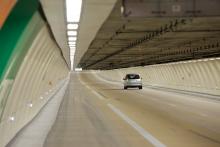
Experts from
However, 23 facilities got good ratings and 48 filling stations were acceptable, while six were rated as poor, although there were no very poor ratings.
During the survey, a checklist of some 80 items were tested and listed including points of entry and exit, filling areas, shops, sanitary facilities, hygiene and prices.
Through EuroTest, an international testing programme for consumer protection, 18 automobile clubs in 17 countries, members of the
"Lack of help for the disabled, unclean sanitary facilities, high prices in shops and petrol price displays not visible on motorways: these are all areas where Europe's motorway filling stations need to do more," says Jacob Bangsgaard, director general of the FIA Region I.
While EuroTest could not give any station the top rating of very good, on the positive side it found that signposting on motorways, safe entry and exit points, comprehensive service amenities (such as disposable gloves or tyre pressure gauges) and the range of goods on offer in shops indicate that most filling stations along motorways are operating at a high level.
The biggest shortcoming, according to EuroTest, concerned hygiene, which was found to be lacking in most stations visited. Half of the toilets inspected were more or less dirty to look at. But even toilets that appear to be clean are not automatically up to scratch in terms of hygiene: around a quarter of hygiene samples collected were found to be potentially hazardous to health, 12 were definitely found to be hazardous to health, and 40% of the samples indicated insufficient cleaning.
"When it comes to hygiene there's plenty of room for improvement by operators concerning how frequently and how thoroughly toilets are cleaned," says the report.
The top five ratings went to eastern European countries: two in the Czech Republic, two in Slovenia and one in Croatia, and in all three countries, the mostly well equipped sanitary facilities; the diverse range of goods on offer and unbeatable prices in their shops formed the foundation for success.
An inspector calls
FILLING STATIONS visited were along the main travel routes in 11 European countries (12 in Germany; nine in Italy and Switzerland; eight in France, the Netherlands and Spain; seven in Austria; and four in Belgium, Croatia, Slovenia and the Czech Republic).
In its capacity as project manager,
The results were analysed between September 2010 and March 2011.
Germany proved to be the most expensive country for goods in filling stations despite ranking fourth in purchasing power among countries visited. Belgium, on the other hand, despite being a rather expensive country (ranked third in purchasing power) was found to have moderate prices. The Czech Republic had the best prices closely followed by Croatia and Slovenia.
"Information, however, is often lacking. While brands are relatively well signposted on the motorway, the picture is completely different when it comes to fuel types and fuel prices. Only 18% of stations displayed this information in advance.
"In this respect, two Dutch and two Slovenian filling stations really took the biscuit: motorists there are only informed of prices at the petrol pump, after lifting the petrol tap!"






